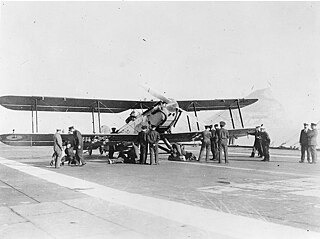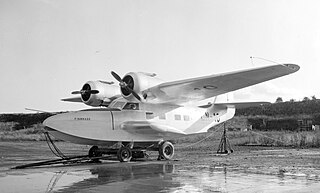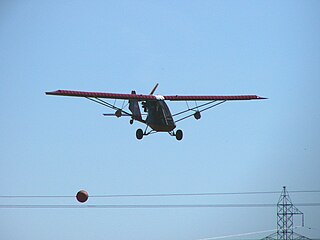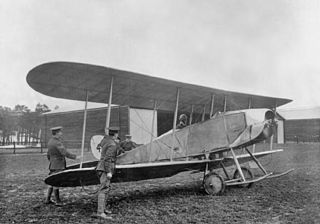
Nielsen & Winther was a Danish machine factory and aeroplane manufacturer based in Copenhagen, Denmark.

Nielsen & Winther was a Danish machine factory and aeroplane manufacturer based in Copenhagen, Denmark.
The machine factory was founded in 1873. It was from 1899 to 1916 based in a building at Blegdamsvej 60 designed by Axel Berg. It then relocated to a new building designed by Frederik Wagner at Ryesgade 51-55 as well as a large new plant at Øresundsvej 147. [1]
The Amager plant was home to a new aeroplane division. It delivered six Nielsen & Winther Type Aa aeroplanes to the Royal Danish Air Force in 1917. [2] One aircraft was delivered to the Royal Norwegian Navy Air Service in 1918. Three of the six Danish aircraft crashed in accidents and the three remaining ones were therefore grounded. The Amager plant was sold to Vølund in 1920. [3]
Aircraft produced by Nielsen & Winther:- Data from A/S Nielsen & Winther [2]
Nielsen & Winther was also the name of a football club founded in 1918 by workers at the factory: [4]
The company's former buildings at Blegdamsvej 60 and Ryesgade 51-55 have survived. The Amager plant, taken over by Vølund, was demolished in 2001. Its premises in the Free Port was taken over by Riffelsyndikatet.

The Royal Aircraft Factory B.E.2 is a British single-engine tractor two-seat biplane, designed and developed at the Royal Aircraft Factory. Most of the roughly 3,500 built were constructed under contract by private companies, including established aircraft manufacturers and firms new to aircraft construction.

The Avro 504 is a single-engine biplane bomber made by the Avro aircraft company and under licence by others. Production during World War I totalled 8,970 and continued for almost 20 years, making it the most-produced aircraft of any kind that served in any military capacity during the First World War. More than 10,000 were built from 1913 until production ended in 1932.

The Fairey Aviation Company Fairey III was a family of British reconnaissance biplanes that enjoyed a very long production and service history in both landplane and seaplane variants. First flying on 14 September 1917, examples were still in use during the Second World War.

The Morane-Saulnier Type P was a French parasol wing two-seat reconnaissance aeroplane of the First World War. Morane-Saulnier built 595 for the French air force, and it was also used by the British until 1916-17.
Luft-Fahrzeug-Gesellschaft, also referred to as LFG, was a German aircraft manufacturer during World War I. They are best known for their various "Roland" designs, notably the Roland C.II Walfisch (whale), Roland D.II haifisch (Shark) and Roland D.VI, although they also produced a number of airships and many experimental designs.

The Handley Page W.8, W.9 and W.10 were British two- and three-engine medium-range biplane airliners designed and built by Handley Page.

The de Havilland DH.53 Humming Bird is a British single-seat, single-engine, low-wing monoplane light aircraft first flown in the 1920s.

The Farman F.60 Goliath was a French airliner and bomber produced by the Farman Aviation Works from 1919. It was instrumental in the creation of early airlines and commercial routes in Europe after World War I.

Blériot Aéronautique was a French aircraft manufacturer founded by Louis Blériot. It also made a few motorcycles between 1921 and 1922 and cyclecars during the 1920s.

The BAT F.K.23 Bantam was a British single-seat fighter biplane produced by British Aerial Transport Company Limited of London during World War I.

The Norsk Flyindustri Finnmark 5A was an amphibious flying-boat airliner built in Norway in the late 1940s. The single prototype was operated by the VLS airline, but no orders for additional aircraft were received, and a refined version designated 5A-II was never built. The Finnmark was a conventional high-wing cantilever monoplane with twin engines housed in nacelles on the wings, and the first twin-engined aircraft constructed in Norway. A specially-designed combination wheel-ski undercarriage retracted into wide sponsons on the sides of the flying boat hull.

The Nielsen & Winther Type AA was a Danish fighter aircraft of the 1910s manufactured by Nielsen & Winther in Copenhagen.
Halberstädter Flugzeugwerke or Halberstadt was a German aircraft manufacturer. It was formed on 9 April 1912 under the name Deutsche Bristol Werke Flugzeug-Gesellschaft mbH in Halberstadt, Province of Saxony.

The Birdman Chinook is a family of single and two-place, pusher configuration, high-wing ultralight aircraft that was first flown on 12 December 1982 and produced by Birdman Enterprises of Edmonton, Alberta, Canada, starting in 1983.

The Cody V was a single-engined biplane built by the British-based American aviation pioneer Samuel Franklin Cody in 1912. It was built from the remains of two of Cody's earlier aircraft, and won the 1912 British Military Aeroplane Competition, with two aircraft being purchased for the Royal Flying Corps. The design was abandoned after the mid-air disintegration of one of the aircraft in April 1913.

The Dunne D.8 of 1912 was a tailless swept wing biplane, designed by J. W. Dunne to have inherent stability. One example was supplied to RAE Farnborough. License-built Burgess-Dunne models were used by the US Signal Corps and United States Navy and the short-lived Canadian Aviation Corps. It was the latter's first and only warplane.

The Royal Aircraft Factory B.E.3 was a single-engined rotary engined biplane developed by the British Royal Aircraft Factory prior to the First World War. The B.E.4 and B.E.7 were virtually identical aircraft that differed only in the engine fitted.
The Mersey Monoplane was a prototype two-seat British pusher configuration monoplane of the early 1910s. A single example was built and entered into the 1912 British Military Aeroplane Competition but crashed during the trials and was destroyed.
Øresundsvej is a street in the East Amager district of Copenhagen, Denmark. It runs from Amagerbrogade in the west to Amager Strandvej in the east.